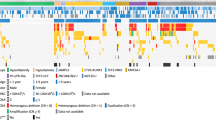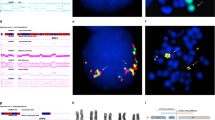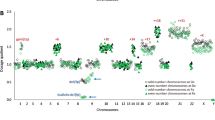Abstract
To gain a fuller understanding of the role of deletions of chromosome 9 in the development of childhood acute lymphoblastic leukemia (ALL), we performed detailed deletional mapping of chromosome 9 in 54 primary ALL samples with matched normal DNA using 22 highly polymorphic markers; and this information was combined with our previous data concerning the presence of deletions of CDKN2/INK4A/p16 and CDKN2B/ INK4B/p15 in these samples. We have found a very high frequency of loss of heterozygosity (LOH) (31 of 54 cases (57%)) on chromosome arm 9p. As expected, the smallest region of LOH was between D9S1747 and D9S1748 at 9p21, including CDKN2/INK4A/p16, but excluding CDKN2B/INK4B/p15. Homozygous deletions at 9p21 occurred in 23 of 54 (43%) samples (seven of 11 (64%) T-ALL, 16 of 45 (36%) precursor-B ALL). We detected seven cases of homozygous deletions at 9p21 which had not been detected by Southern blot hybridization, showing the power of microsatellite analysis in detecting homozygous deletions. In most cases, homozygous deletions were limited to the region between D9S1747 and CDKN2B/INK4B/p15. We have attempted to determine the mechanism and timing of 9p deletions. Of the 23 samples with homozygous deletions at 9p21, 21 samples had surrounding large LOH. Of the 29 samples with LOH of 9p, homozygous deletion at 9p21 was identified in 22 cases. In addition, six patients have been studied at diagnosis and relapse, all six showed the same 9p21 structure at relapse (normal, three patients; hemizygous deletions, two patients; homozygous deletion, one patient) as their initial presentation. Finally, three patients (homozygous deletion, one patient; hemizygous deletion, two patients) had the IFN-α rather than CDKN2/INK4A/p16 deleted. In summary, these data further emphasize the importance of 9p21 loss in the development of childhood ALL.
This is a preview of subscription content, access via your institution
Access options
Subscribe to this journal
Receive 12 print issues and online access
$259.00 per year
only $21.58 per issue
Buy this article
- Purchase on Springer Link
- Instant access to full article PDF
Prices may be subject to local taxes which are calculated during checkout
Similar content being viewed by others
Author information
Authors and Affiliations
Rights and permissions
About this article
Cite this article
Takeuchi, S., Koike, M., Seriu, T. et al. Homozygous deletions at 9p21 in childhood acute lymphoblastic leukemia detected by microsatellite analysis. Leukemia 11, 1636–1640 (1997). https://doi.org/10.1038/sj.leu.2400817
Received:
Accepted:
Issue Date:
DOI: https://doi.org/10.1038/sj.leu.2400817
Keywords
This article is cited by
-
Identifying novel homozygous deletions by microsatellite analysis and characterization of tumor suppressor candidate 1 gene, TUSC1, on chromosome 9p in human lung cancer
Oncogene (2004)
-
Allelotype analysis in relapsed childhood acute lymphoblastic leukemia
Oncogene (2003)
-
Long-term study of the clinical significance of loss of heterozygosity in childhood acute lymphoblastic leukemia
Leukemia (2003)
-
Detection of methylthioadenosine phosphorylase (MTAP) and p16 gene deletion in T cell acute lymphoblastic leukemia by real-time quantitative PCR assay
Leukemia (2000)



